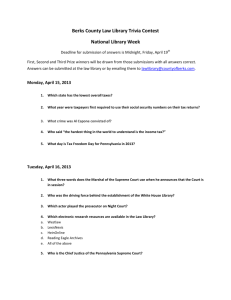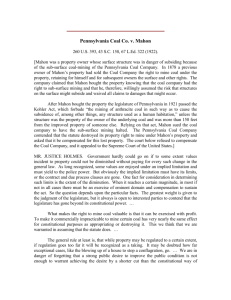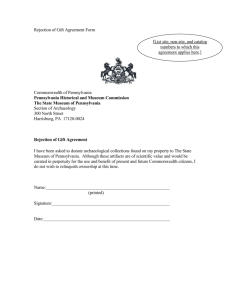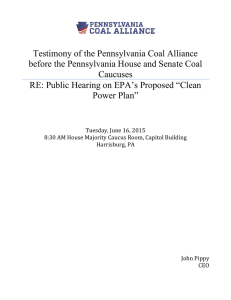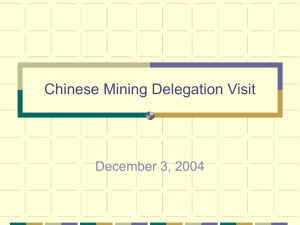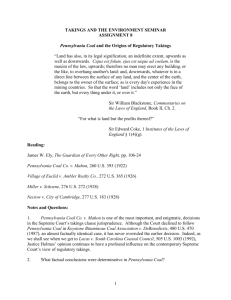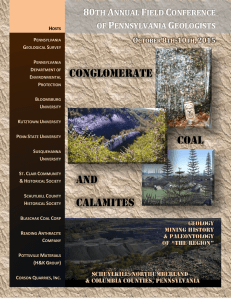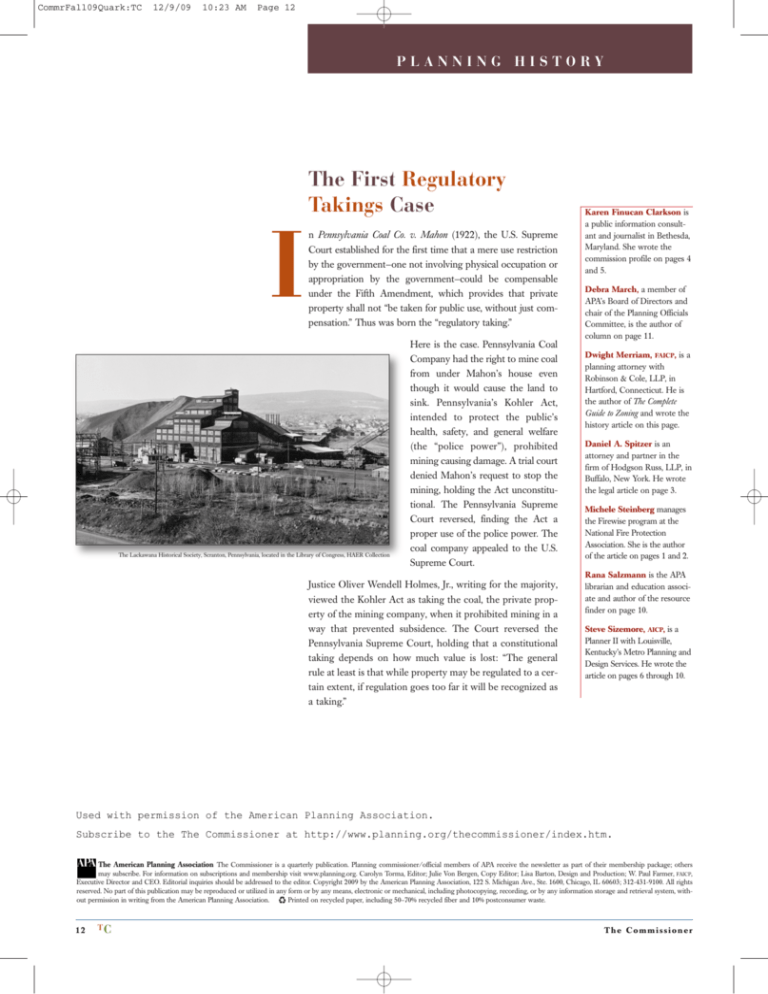
CommrFall09Quark:TC
12/9/09
10:23 AM
Page 12
PLANNING HISTORY
The First Regulatory
Takings Case
I
n Pennsylvania Coal Co. v. Mahon (1922), the U.S. Supreme
Court established for the first time that a mere use restriction
by the government—one not involving physical occupation or
appropriation by the government—could be compensable
under the Fifth Amendment, which provides that private
property shall not “be taken for public use, without just compensation.” Thus was born the “regulatory taking.”
The Lackawana Historical Society, Scranton, Pennsylvania, located in the Library of Congress, HAER Collection
Here is the case. Pennsylvania Coal
Company had the right to mine coal
from under Mahon’s house even
though it would cause the land to
sink. Pennsylvania’s Kohler Act,
intended to protect the public’s
health, safety, and general welfare
(the “police power”), prohibited
mining causing damage. A trial court
denied Mahon’s request to stop the
mining, holding the Act unconstitutional. The Pennsylvania Supreme
Court reversed, finding the Act a
proper use of the police power. The
coal company appealed to the U.S.
Supreme Court.
Justice Oliver Wendell Holmes, Jr., writing for the majority,
viewed the Kohler Act as taking the coal, the private property of the mining company, when it prohibited mining in a
way that prevented subsidence. The Court reversed the
Pennsylvania Supreme Court, holding that a constitutional
taking depends on how much value is lost: “The general
rule at least is that while property may be regulated to a certain extent, if regulation goes too far it will be recognized as
a taking.”
Karen Finucan Clarkson is
a public information consultant and journalist in Bethesda,
Maryland. She wrote the
commission profile on pages 4
and 5.
Debra March, a member of
APA’s Board of Directors and
chair of the Planning Officials
Committee, is the author of
column on page 11.
Dwight Merriam, FAICP, is a
planning attorney with
Robinson & Cole, LLP, in
Hartford, Connecticut. He is
the author of The Complete
Guide to Zoning and wrote the
history article on this page.
Daniel A. Spitzer is an
attorney and partner in the
firm of Hodgson Russ, LLP, in
Buffalo, New York. He wrote
the legal article on page 3.
Michele Steinberg manages
the Firewise program at the
National Fire Protection
Association. She is the author
of the article on pages 1 and 2.
Rana Salzmann is the APA
librarian and education associate and author of the resource
finder on page 10.
Steve Sizemore, AICP, is a
Planner II with Louisville,
Kentucky’s Metro Planning and
Design Services. He wrote the
article on pages 6 through 10.
Used with permission of the American Planning Association.
Subscribe to the The Commissioner at http://www.planning.org/thecommissioner/index.htm.
The American Planning Association The Commissioner is a quarterly publication. Planning commissioner/official members of APA receive the newsletter as part of their membership package; others
may subscribe. For information on subscriptions and membership visit www.planning.org. Carolyn Torma, Editor; Julie Von Bergen, Copy Editor; Lisa Barton, Design and Production; W. Paul Farmer, FAICP,
Executive Director and CEO. Editorial inquiries should be addressed to the editor. Copyright 2009 by the American Planning Association, 122 S. Michigan Ave., Ste. 1600, Chicago, IL 60603; 312-431-9100. All rights
reserved. No part of this publication may be reproduced or utilized in any form or by any means, electronic or mechanical, including photocopying, recording, or by any information storage and retrieval system, without permission in writing from the American Planning Association. C Printed on recycled paper, including 50–70% recycled fiber and 10% postconsumer waste.
12
TC
The Commissioner

